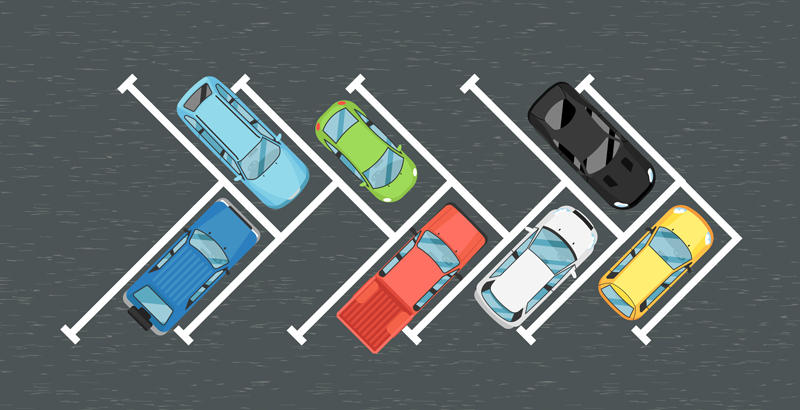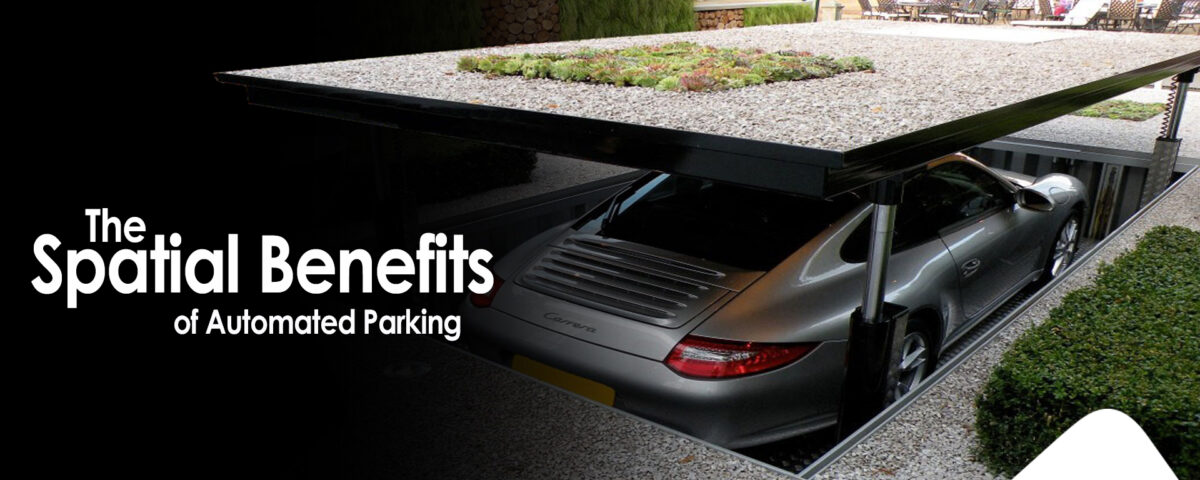
Parking regulations in Miami Changed, is that the solution?
January 17, 2020The Future of the Car Vending Machine
February 25, 2020Learn the spatial benefits of automated parking and why real estate developers and architects should consider this as a parking solution.
This is the first of a series of four videos talking about the Spatial, Economic, Environmental and Social advantages of automated parking. Would you rather read the information instead? Check out the video transcript below.
This is the first of a series of four videos talking about the Spatial, Economic, Environmental and Social advantages of automated parking. Would you rather read the information instead? Check out the video transcript below.
Spatial Benefits of Automated Parking (Transcript)
Click here to Expand
Hello, this is Paula with Automated Parking Corporation. This is the first of a series of four videos where we are going to discuss and explore the spatial, economic, environmental and social advantages of automated parking technology.
The most common feature known about automated parking technology is actually, their space-saving superpowers; how these technologies can dramatically reduce the space that is devoted to parking in any real estate development a lot of people is interested in the ratios like how much space can they really save using this technology versus older traditional parking methods, such as surface slots or concrete ramp garages.
Well it's not an easy answer because it really depends on the geometry of the land, on the design of the building, you know, on the goals; but as a rule of thumb we can say that the space can be reduced from 50 to 70 percent meaning that, you can free from 50 percent of your land to 70 percent of the land to park the same amount of vehicles in the same square footage.
That means that you're freeing-up up to 70 percent of your land for more relevant uses such as more commercial real estate, more residential amenities, green spaces, giving a lot more flexibility to architects and developers to actually make much better use of their land. Most people then ask how is this possible? The answer is very simple. Every single task of parking and retrieving vehicles in an automatic parking system is actually performed by the machines. You don't need any ramps, any elevators, any stairs and you are going to need the drive aisle space only on the lowering level. Some systems load on the top, some systems load on the bottom, the most commonly on the bottom but that is the only place where you're gonna need drive aisle.
This means that you're gonna free all the space that is otherwise will be dedicated to the drive aisle on the upper levels of the system to actually build more building, more amenities, so only one level of drive-aisle.
This space-saving capability allows developers to develop land that they could not develop before. We have had cases of developers that have look at land and they have decided not to proceed with development because of the parking ratios, and the land was so small that the profitable part of the development which is an income-producing square footage was not enough or was not worth it or was not profitable enough for them to actually proceed with the development due to the parking requirements.
So this technology will actually allow developers to take a second look at properties that before did not make sense in terms of investment because they can, again, dramatically reduce the space devoted to parking, that, you know especially in the in the cases where parking is free it's a burden to develop it is a cost that is actually passed on to the final customer or the final consumer of that development.
Another very important capability of automated parking systems is that they really make possible what is called infill development which means, there's especially in dense centers in downtown's, they have smaller lots of land because everything is already developed.
They (infill development) have the smaller lots of land where they can actually build something new because they can actually fulfill the parking requirement using this type of technology; this is very important especially in community redevelopment programs where they're trying to increase and get the economic activity of the area and they want to provide more services and products for the customers, but they don't have any more space so they need to revitalize the area so you can actually build in smaller portions of land.
And especially for parking, you can also build smaller lots instead of like a big lot on one side of that urban center because people usually don't like to walk more than 200 yards from their final destinations.
With this technology, you can actually build smaller lots, smaller parking facilities distributed all around the center allowing the consumers to actually park closer to their final destinations, and these will contribute with very modern urban concepts such as walkability. Another very important, you know, advantage of these technologies is for historic preservation. Buildings that can not always be touched because of their historic value sometimes developers are very interested because they have like a special appeal to consumers and they still have some space that they can still develop more or revitalize those buildings, and they cannot do it because of the parking requirements.
These machines, these systems, have the capability to adapt to this already existing space and you can fit one of them inside a building that you're revitalizing and then make this project possible.
What we have seen throughout the years in our experience in this industry since we've been active, is that actually automated parking technology has been contributing greatly to make projects, that were unfeasible before, to make these projects feasible.
Giving opportunity, again, to architects and developers to actually take second look at lands that before they had to discard; or to actually like super optimize their current developments because even if you have the space to comply with the parking requirement it is more advantageous that you reduce the space devoted to parking, especially if parking is free and then you can maximize your investment by creating more income-producing square footage.
They're very economical and they make a lot of sense in terms of investments so we suggest that you actually take a look, shop around and see you know if this technology is actually right for your development/.
Thank you and stay tuned for the other three videos of this series we are going to discuss also the economic advantages, the environmental advantages, and the social advantages of automated parking systems.
Thanks for watching and don't forget to subscribe.
The most common feature known about automated parking technology is actually, their space-saving superpowers; how these technologies can dramatically reduce the space that is devoted to parking in any real estate development a lot of people is interested in the ratios like how much space can they really save using this technology versus older traditional parking methods, such as surface slots or concrete ramp garages.
Well it's not an easy answer because it really depends on the geometry of the land, on the design of the building, you know, on the goals; but as a rule of thumb we can say that the space can be reduced from 50 to 70 percent meaning that, you can free from 50 percent of your land to 70 percent of the land to park the same amount of vehicles in the same square footage.
That means that you're freeing-up up to 70 percent of your land for more relevant uses such as more commercial real estate, more residential amenities, green spaces, giving a lot more flexibility to architects and developers to actually make much better use of their land. Most people then ask how is this possible? The answer is very simple. Every single task of parking and retrieving vehicles in an automatic parking system is actually performed by the machines. You don't need any ramps, any elevators, any stairs and you are going to need the drive aisle space only on the lowering level. Some systems load on the top, some systems load on the bottom, the most commonly on the bottom but that is the only place where you're gonna need drive aisle.
This means that you're gonna free all the space that is otherwise will be dedicated to the drive aisle on the upper levels of the system to actually build more building, more amenities, so only one level of drive-aisle.
This space-saving capability allows developers to develop land that they could not develop before. We have had cases of developers that have look at land and they have decided not to proceed with development because of the parking ratios, and the land was so small that the profitable part of the development which is an income-producing square footage was not enough or was not worth it or was not profitable enough for them to actually proceed with the development due to the parking requirements.
So this technology will actually allow developers to take a second look at properties that before did not make sense in terms of investment because they can, again, dramatically reduce the space devoted to parking, that, you know especially in the in the cases where parking is free it's a burden to develop it is a cost that is actually passed on to the final customer or the final consumer of that development.
Another very important capability of automated parking systems is that they really make possible what is called infill development which means, there's especially in dense centers in downtown's, they have smaller lots of land because everything is already developed.
They (infill development) have the smaller lots of land where they can actually build something new because they can actually fulfill the parking requirement using this type of technology; this is very important especially in community redevelopment programs where they're trying to increase and get the economic activity of the area and they want to provide more services and products for the customers, but they don't have any more space so they need to revitalize the area so you can actually build in smaller portions of land.
And especially for parking, you can also build smaller lots instead of like a big lot on one side of that urban center because people usually don't like to walk more than 200 yards from their final destinations.
With this technology, you can actually build smaller lots, smaller parking facilities distributed all around the center allowing the consumers to actually park closer to their final destinations, and these will contribute with very modern urban concepts such as walkability. Another very important, you know, advantage of these technologies is for historic preservation. Buildings that can not always be touched because of their historic value sometimes developers are very interested because they have like a special appeal to consumers and they still have some space that they can still develop more or revitalize those buildings, and they cannot do it because of the parking requirements.
These machines, these systems, have the capability to adapt to this already existing space and you can fit one of them inside a building that you're revitalizing and then make this project possible.
What we have seen throughout the years in our experience in this industry since we've been active, is that actually automated parking technology has been contributing greatly to make projects, that were unfeasible before, to make these projects feasible.
Giving opportunity, again, to architects and developers to actually take second look at lands that before they had to discard; or to actually like super optimize their current developments because even if you have the space to comply with the parking requirement it is more advantageous that you reduce the space devoted to parking, especially if parking is free and then you can maximize your investment by creating more income-producing square footage.
They're very economical and they make a lot of sense in terms of investments so we suggest that you actually take a look, shop around and see you know if this technology is actually right for your development/.
Thank you and stay tuned for the other three videos of this series we are going to discuss also the economic advantages, the environmental advantages, and the social advantages of automated parking systems.
Thanks for watching and don't forget to subscribe.
If you find this video helpful, don't forget to subscribe to our YouTube Channel. We release videos every Wednesday.




